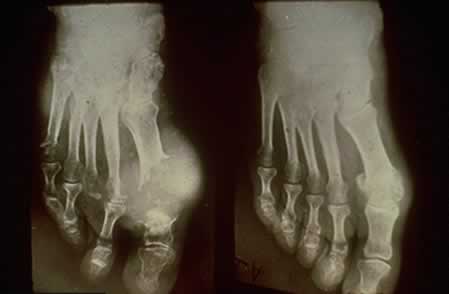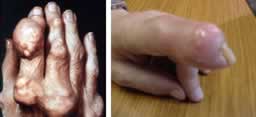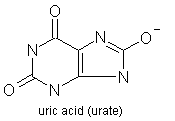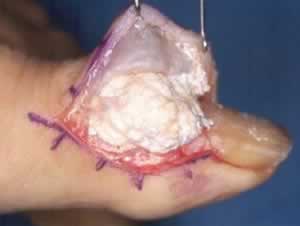Gout
Gout or gouty arthritis is
a metabolic disease marked with uric acid or
urate crystal deposits, which
causes a severe arthritis or joint pain. Gout can occur in any
joint, but is usually found in the feet and legs.
The term “gout” comes from the latin word “gutta”
meaning “a drop” which describes the large lump of
urate deposits.
Gout flares or attacks are intermittent – the patients
often have years of no symptoms between attacks. Gout can create
chronic disability, and in some rare cases, severe hypertension
or high blood pressure and even kidney failure.
Symptoms of Gout
The symptoms of gout include:
- pain
- swelling or inflammation
- redness (dusky-red or cyanotic joint)
- warmness in the joint
- stiffness in the joint

X-ray of gouty uric acid deposit in the
big toe (left).

Large tophi or uric acid deposits in the
hand and fingers.
For most people, the first attack of gout occurs in the big toe,
resulting in very sore, painful, swollen, warm and red toe. It
can even awaken a person from sleep. However, it can also affect:
- ankle
- heel
- instep
- knee
- wrist
- finger
- elbow
- spine
In some cases, the patient has a low-grade fever. Mild attacks
usually go away quickly, but can occur at irregular intervals.
Severe acute attacks can last days or even weeks.
Causes of Gout
The exact cause of gout is not yet known, although it is suspected
to be linked to a genetic defect in purine metabolism. Purine
is a double-ringed, crystalline organic compound commonly found
in the body. It is also found in many foods, including beans and
peas, sweetbreads, anchovy, herring, and liver.
 In
people with primary gout, defect in purine metabolism cause hyperuricemia
(also spelled hyperuricaemia) or high levels of uric acid in the
blood. This can be caused by increased production of uric acid,
abnormal retention of uric acid, or both.
In
people with primary gout, defect in purine metabolism cause hyperuricemia
(also spelled hyperuricaemia) or high levels of uric acid in the
blood. This can be caused by increased production of uric acid,
abnormal retention of uric acid, or both.
In gout, the uric acid becomes insoluble and form crystals that
deposit in various joints.

Uric acid or urate crystals.
Primary gout usually occurs in men and postmenopausal women.
Secondary Gout
Gout can also develop during a course of another disease, such
as:
- obesity
- diabetes mellitus
- hypertension or high blood pressure
- sickle cell anemia
- kidney or renal disease
- hyperuricemia caused by breakdown of nucleic acids
- myeloproliferative and lymphoproliferative diseases
- psoriasis
- hemolytic anemia (premature destruction of red blood cells,
causing anemia or inadequate number of circulating red blood
cells).
This form of gout is called secondary gout, and is most commonly
found in elderly people. Secondary gout can result from side effects
of medications, such as drugs that interfere with uric acid secretions.
Stages of Gout
Gout has 4 stages:
- asymptomatic
- acute
- intercritical
- chronic
In asymptomatic gout, the blood levels of uric acid rise but
there is no symptom yet. In the acute stage is marked with painful
joints. The intercritical period are symptom-free intervals between
gout attacks. This can last months or even years – however
most people have their second attack within 6 months to 2 years.
In some cases, the second attack does not occur for 5 to 10 years.
Left untreated, the second gout attack usually last longer and
is more severe than the first one. It can also be polyarticular
or affect multiple joints, usually the joints in the feet and
legs, and can be accompanied by a fever.
Secondary gout attack can also “migrate” that is
sequentially attacking various joints, including the Achilles
tendon. A condition called bursitis or inflammation of the bursa
(a sac containing joint lubricating fluids) can also be present.
In the last stage, chronic gout affects multiple joints all the
time. In this stage, pain at multiple joints persists and large
lumps of uric acid deposits called tophi (singular:
tophus) are present. Chronic inflammation and
the presence of tophi in the joints can accelerate joint degeneration,
which can lead to deformity and disability.
In advanced chronic gout, damage to the kidney caused by uric
acid deposit can cause kidney failures. Other conditions, such
as hypertension (high blood pressure), albuminuria (abnormal presence
of albumin protein in the urine indicating kidney disease), and
urolithiasis (urinary stone in the urinary tract) can also develop.
Tophi
Tophi or uric acid deposits are found in :
- cartilage
- synovial membrane (membrane covering the joints)
- tendons
- soft tissues
Tophi can occur in various organs, including:
- finger
- hand
- knee
- foot
- ear
- elbow
- Achiles tendon
- spine
- internal organs, such as kidney and even heart
The skin over the tophi lumps can form ulcers and secrete pus.
Diagnosis of Gout
The signs and symptoms of gout include:
- hyperuricemia
- monosodium urate monohydrate or uric acid crystals in the
joint fluid or synovial fluid of an inflamed joint or from a
tophus
- More than one attack of acute arthritis
- Sudden flare up or arthritis that develop quickly (1 day)
- Swollen joint
- Dusky-red or cyanotic joint
- Warmness in the joint
- Arthritis attack only in 1 joint, usually the big toe, ankle,
or knee.
Urinary uric acid is usually higher in secondary gout than in
primary gout. In acute attack, blood test can reveal elevated
white blood cell count (it also shifts to the left) and elevated
erythrocyte sedimentation rate.
In chronic gout, X-ray can show “punched out” lesions
and overgrowth of the periosteal membrane (a dense fibrous membrane
that covers the surface of bones and serves as an attachment for
muscle and tendon). X-ray does not usually show the presence of
tophi.
Gout treatment
Treatment of gout includes treating the acute attack, reducing
the uric acid level in the blood, and to prevent future attacks.
Medical treatment of acute gout attack includes:
- Nonsteroidal anti-inflammatory drugs (NSAIDs), such as ibuprofen
(brand names such as Advil, Motrin, and Nuprin)
- Colchicine, which is very effective when taken within the
first 12 hours of the onset of the attack and usually relieves
the pain within 48 hours.
- Resistant gout attack or inflammation may require oral or
injection of corticosteroid into the joint to relieve pain.
Your doctor may also prescribe:
- bed rest
- immobilization of the joint
- hot or cold compress to help relieve the pain and inflammation
- NSAIDs or colchicines to be taken daily in small doses to
prevent future flare ups.
To reduce the levels of uric acid in the blood, your doctor may
prescribe:
- Allopurinol, a drug that inhibits the formation of uric acid
- Uricosuric agents which promote excretion and inhibit the
accumulation of uric acid
These two medications should be cautiously given to patients
with renal or kidney conditions and should not be given at all
to those with renal calculi or kidney stones.
In severe cases of gout, surgery may be the only option. Here,
the tophi are excised and drained to improve joint functions and
correct any deformity.

Surgical removal of the the uric acid deposit
in gout.
In addition to these treatments above, the patients should be
advised to:
- Avoid purine-rich foods (such as meat, beer and wine)
- Lose weight, especially for obese patients since the weights
put extra pressure on the joints
References


